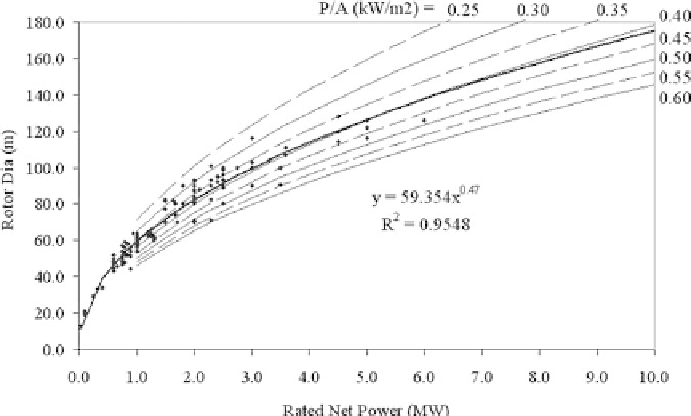Environmental Engineering Reference
In-Depth Information
Figure 2: Industry study set w.r.t. lines of constant specifi c rating (
P
/
A
).
power in Fig. 2. Specifi c rating is defi ned as the rated net power of the turbine
divided by the rotor swept area (
P
/
A
) and is typically used to characterize the over-
all ability of a design to economically extract electrical energy from the wind. The
majority of today's large WTs have a specifi c rating in the range of 300
500 W/m
2
.
The general trend passes from specifi c ratings of less than 400 W/m
2
for machines
below 4
−
5 MW sizes to greater than 400 W/m
2
for WTs above 4
5 MW sizes.
This result is due to plotting all the turbines within the study set without regard
for their particular International Electrotechnical Committee (IEC) type class
(TC). See IEC 61400-1 for an explanation of WT design TC [12, 13]. In general,
turbines installed in the EU are typically designed to IEC TC3 and turbines for the
U.S. to TC2. Offshore turbines are typically designed to meet the requirements for
IEC TC1. Today's largest machines are generally for offshore or IEC TC I applica-
tions. These TC1 data points pull the average trend line towards higher specifi c
ratings with increasing rated net power.
To better illustrate this point, Fig. 3 shows the same data plotted by IEC TC,
together with the study group trend line. The TC data shows that today's utility
scale turbines have specifi c ratings independent of machine size; TC3 turbines
(7.5 m/s) have an average specifi c rating of 327 W/m
2
, TC2 (8.5 m/s) of about
362 W/m
2
and TC1 (10 m/s) at 425 W/m
2
. The standard deviation for these results
is approximately 7%, 10% and 13% for TC3, TC2 and TC1, respectively.
The industry study set dimensions for 10 turbines along the mean characteris-
tic for the 150+ turbine data set are plotted in Fig. 4. While it cannot be asserted
that turbines in the 5
−
−
10 MW range will end up having precisely these dimen-
sions, this does help to characterize a reasonable starting point. The tower height,
rotor diameter and rating are consistent with the natural progression of marketable
designs that have so far balanced higher electrical output per kg of material, cost
−

Search WWH ::

Custom Search